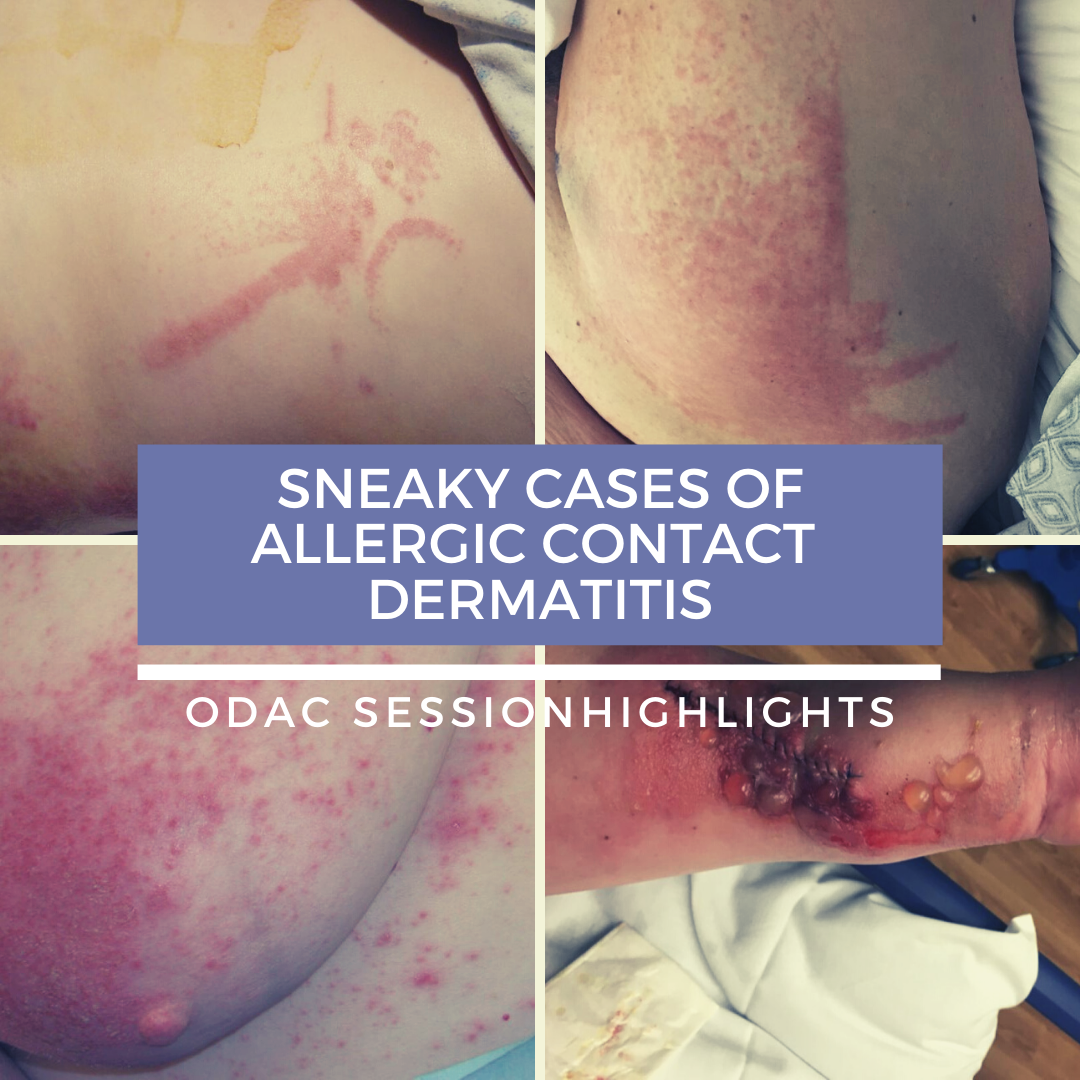We all think about allergic contact dermatitis when a patient presents with a classic well-demarcated distribution of eczematous, pruritic rash. But under what other clinical scenarios should we consider the diagnosis of allergic contact dermatitis? At the 17th Annual ODAC Dermatology, Aesthetic and Surgical Conference, Dr. Jonathan Zippin discussed three different clinical conundrums that should spark consideration of allergic contact dermatitis and he provided many practical pearls for the audience.
“Why is my atopic dermatitis worse?”
In the first clinical vignette, imagine a pediatric patient with a diagnosis of atopic dermatitis, well-controlled on emollients and topical steroids. Over the course of a year, his rash has changed in distribution and severity. The mother wants to know why the previously successful therapy is no longer working.
-
- Sensitization to allergens is very common in children, especially among those with atopic dermatitis. In one study¹, children with atopic dermatitis were nearly 17 times more likely to have at least one relevant positive patch test and were over 100 times more likely to have “generalized” allergic contact dermatitis.
- Many of the allergens with relevant positive patch testing in children with atopic dermatitis are components of general skin products and topical medications used to treat atopic dermatitis.
For this patient, it is important to consider that the patient may be worsening due to allergic contact dermatitis to something in the topical products and medications used for his atopic dermatitis. He improved after patch testing revealed lanolin allergy and his products were changed.
“Why do I have this new rash?”
In the second clinical vignette, a pediatric patient with atopic dermatitis presents to the office with a brand-new rash around the scalp and ears. She has been using only gentle products and has not changed anything in her environment.
-
- Children react to different allergens than adults. For example, they have higher rates of reactivity to propylene glycol and cocamidopropyl betaine compared to adults.
- Cocamidopropyl betaine is an emulsifying agent used in shampoos, soaps, and toothpaste.
- Cocamidopropyl betaine is supposed to be less irritating and is often found in products made for those with sensitive skin.
For this patient, she had positive patch testing to Cocamidopropyl betaine, and her new rash improved with changing her shampoo.
“I am avoiding all my positive allergens! Why isn’t my rash getting better?”
In the third clinical vignette, an adult patient with known allergic contact dermatitis to balsam of Peru and fragrance mix is still not improving, despite avoiding her allergens. She admits to eating a heavily plant-based diet, including lots of tomatoes and citrus.
-
- Systemic contact dermatitis (SCD) occurs when sensitized patients are re-exposed to known type IV, lymphocyte-mediated allergens, resulting in a cutaneous, mucosal, or visceral immune reaction.
- The exposure can be via various routes (i.e. transepidermal/mucosal, oral, IV, subcutaneous, IM, inhalation, or implantation).
- SCD can present with a wide spectrum of morphologies including vesicular hand dermatitis, general morbilliform eruptions, chronic or perianal pruritus, chronic urticaria, or even EM or AGEP-like reactions.
- When thinking about dietary exposures causing SCD, consider urushiol, nickel, balsam of Peru, compositae/sesquiterpene lactone, formaldehyde, propylene glycol, and carmine as possible allergens.
For this patient, she was encouraged to try a Balsam of Peru free diet for 3 months. Using a food diary or app can be helpful for patients. They can also reintroduce foods at one-week intervals to see if a specific food can be identified as a trigger.
Take-home points
Patch testing should be considered for children with atopic dermatitis whose disease flair despite proper skincare or who get a new rash in areas that are not typical for atopic dermatitis. Patients with atopic dermatitis have higher rates of sensitization compared to the general population and develop hypersensitivity to allergens that are not typical in the general population. Finally, systemic contact dermatitis should be considered in patients with known allergen sensitivity who aren’t getting better despite avoiding allergens.
References
-
- Goldenberg A, Mousdicas N, Silverberg N, Powell D, Pelletier JL, Silverberg JI, et al. Pediatric Contact Dermatitis Registry Inaugural Case Data. Dermatitis. 2016;27(5):293-302.
This information was presented by Dr. Jonathan Zippin, MD, PhD at the 17thODAC Dermatology, Aesthetic and Surgical Conference held January 17th-20th, 2020 in Orlando, FL. The above highlights from his lecture were written and compiled by Dr. Carolina Laggis, Chief Dermatology Resident at the University of Utah in Salt Lake City, UT, and one of the 7 residents selected to participate in the Sun Young Dermatology Leader Mentorship Program (a program supported by an educational grant from Sun Pharmaceutical Industries, Inc.).
Did you enjoy this article? Find more on Medical Derm here.


